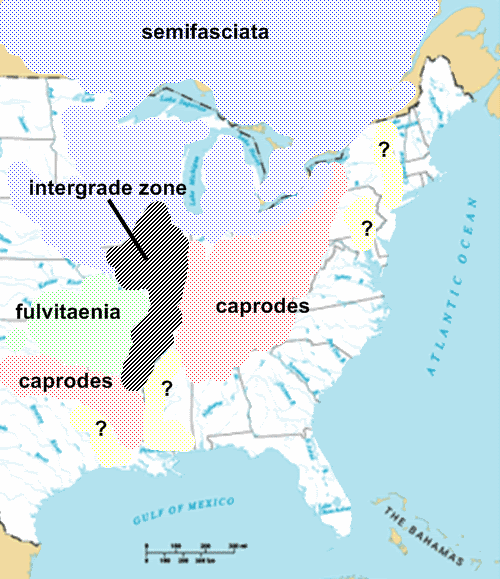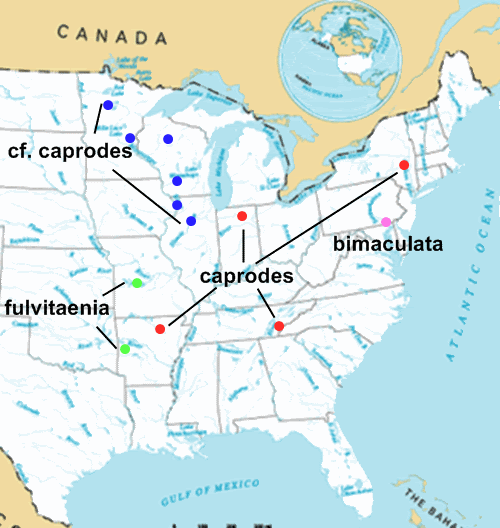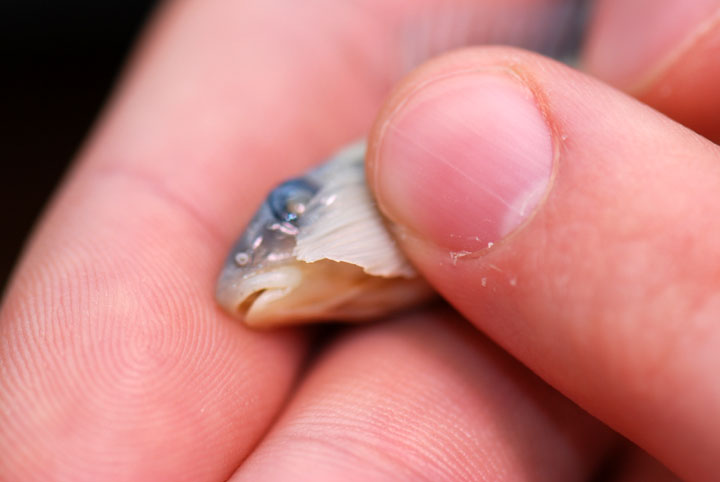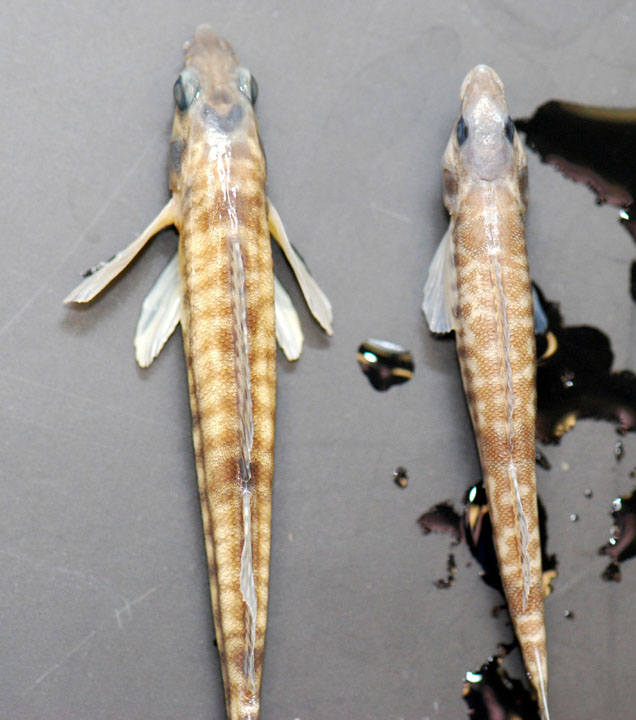As I was driving home, I became more and more interested in this idea.
Building a "Darterbase" (nee Ulocentra questions)
#21
 Guest_farmertodd_*
Guest_farmertodd_*
Posted 11 January 2010 - 06:38 PM
As I was driving home, I became more and more interested in this idea.
#22
 Guest_Newt_*
Guest_Newt_*
Posted 11 January 2010 - 07:01 PM
I would like to start mapping some of these newly described/delimited species from the verified specimens used in the phylogenetic studies, with overlays of drainage, stream order, and physiographic region to allow a better view of where these things are living than the HUC-level maps NatureServe has or the printed maps from the studies. Restricting plotted points to verified (by study authors, not by me) specimens will make it slightly more relevant, and loads less work than an exhaustive museum survey. I just have to figure out how to make the maps. In-browser GIS apps are clunky, but maybe I can create transparent GIF overlays that can be turned on or off... I will see what I can learn. I probably won't be able to really knuckle down on this until May, but I can do the preliminary planning at least.
#23
 Guest_BTDarters_*
Guest_BTDarters_*
Posted 13 January 2010 - 06:31 AM
Brian
#26
 Guest_Newt_*
Guest_Newt_*
Posted 14 January 2010 - 05:07 PM
1. The map indicates that P. caprodes is found all the way south to the Sabine and Pascagoula. These rivers are in the ranges of P. macrolepida and P. suttkusi, respectively. Are P. caprodes sympatric with these other logperch in these systems?
2. What is the range of P. fulvitaenia, and is it a valid species? The original description (as P. caprodes fulvitaenia) includes an enormous intergrade zone with P. c. semifasciata and a smaller one with P. c. caprodes, which would argue against species status, and I have seen no more recent papers dealing with it; its elevation seems to have just happened spontaneously.
3. What are the ranges and statuses of the remaining nominal subspecies of P. caprodes, the nominate race and P. c. semifasciata? The sources I have seen simply relegate P. c. semifasciata to "northern part of range" or "north of 41 degrees latitude", which is rather vague for my taste.
#27
 Guest_farmertodd_*
Guest_farmertodd_*
Posted 14 January 2010 - 07:46 PM
1) Could just be old records (pre-description) that weren't updated and were for "caprodes".
2) Which papers do you have Nathan?
Variation in western logperches, with description of a new subspecies from the Ozarks, Copeia 1981(1):95-108 (can send to you)
This one seems to be available to anyone: http://libinfo.uark....96v50/v50a5.pdf
3) The northern end is a mess.
Todd
#28
 Guest_Newt_*
Guest_Newt_*
Posted 14 January 2010 - 08:25 PM
Going by that paper, P. c. caprodes is found in two disjunct populations: an eastern disjunct in the Ohio and its major tribs, including Wabash, Cumberland, and Tennessee; and a southwestern disjunct in the Red/Ouachita and lowermost Mississippi. P. c. semifasciata are in the Great Lakes, upper Mississippi, and the Missouri north of the state of Missouri. P. c. fulvitaenia is in the lower Missouri tribs, the Arkansas, and Blue River (a Red River trib). The huge intergrade zone between P. c. fulvitaenia and the other two includes Mississippi tribs from at least the Illinois south to include the White, Black, and St. Francis on the west and "Western Tennessee" on the east. Oddly enough, no intergrades were examined between the two subspecies left in P. caprodes. No word on Atlantic slope populations.

#30
 Guest_Newt_*
Guest_Newt_*
Posted 14 January 2010 - 09:09 PM

So, the Potomac/Susquehanna logperch are P. bimaculata, the Hudson and at least part of the "fulvitaenia X caprodes" intergrade zone are occupied by good P. c. caprodes, and upper Mississippi "semifasciata" aren't all that closely related to P. c. caprodes. No samples from Great Lakes or Hudson Bay drainages.
About to read the second paper he sent me.
#33
 Guest_farmertodd_*
Guest_farmertodd_*
Posted 14 January 2010 - 10:56 PM
http://www.ideals.il....pdf?sequence=2
I noticed Chris doesn't have it in the NANFA list.
Todd
#34
 Guest_Newt_*
Guest_Newt_*
Posted 14 January 2010 - 11:12 PM
IIRC, meristically (but not genetically) distinct lake ecomorphs of E. nigrum have been described. On the other hand, E. perlongum was once considered a lake ecomorph of E. olmstedi and is now accepted as valid. Similarly, the Eurycea aquatica complex was for a long time synonymized with E. cirrigera because it was thought to be a spring ecomorph.
#36
 Guest_farmertodd_*
Guest_farmertodd_*
Posted 15 January 2010 - 10:03 AM
Very interesting! The Indiana P. caprodes from Dr. Near's study (see second map below) is from Lake Wawasee; would that be in the range of the "Indiana logperch"?
Quite and I'm sure that's why Tom included it. His results beg more questions than they resolve, imho. Wawasee, for example, is now almost completely armored (thus a significant anthropogenic change) and there have been great efforts to remove vegetation.
So was manitou not real - merely plasticity, a race within the species complex, a subspecies, a species, and are they getting hybridized out with the anthropogenic changes? I don't feel this is adequately resolved with the evidence below...
IIRC, meristically (but not genetically) distinct lake ecomorphs of E. nigrum have been described. On the other hand, E. perlongum was once considered a lake ecomorph of E. olmstedi and is now accepted as valid.
This is a question that I'd like to work on this winter and spring with individuals I found in a less disturbed lake in Michigan (if you know where these are from, let's keep it quiet, please!!
Here's an example of what could be plastic traits but beg further investigation. The "river form" is from elsewhere in the watershed, the "lake form" from this particular lake.
River Form

Lake Form

Side by Side with two comparably sized individuals - the lake form are much much smaller, any that I am showing you are spawning adults (top out at about 70mm TL).

Life colors - can you tell me which is which? These specimens are both from lakes that are less than 10 miles apart and a part of the same drainage network.

Plastic traits? Could be. Where I found them spawning is an even more intriguing phenomena, completely different ecology, and one that would have been modified in Wawasee (as well as my second logperch from the nearby lake). I hope film, photograph and publish this with information I collect this spring.
I've got them ready for some merisitcs, Amanda and I are going to look at them once I get a couple grant proposals off my desk to see if there's any other differences.
Todd
Edited by farmertodd, 15 January 2010 - 10:07 AM.
#37
 Guest_Newt_*
Guest_Newt_*
Posted 15 January 2010 - 11:14 AM
Fundulus- P. burtoni is on my list! According to Etnier and Starnes it hasn't been caught in the Cumberland in some time and may be extirpated there; I don't know if any have been found in the Cumberland since then.
The current taxa list for the P. caprodes group is as follows:
P. austroperca- Southern Logperch- Gulf Coast drainages east of Mobile Bay (Escambia and Choctawatchee)
P. bimaculata- Chesapeake Logperch- Potomac (extirpated) and Susquehanna
P. burtoni- Blotchside Logperch- Upper Cumberland (possibly extirpated) and Tennessee
P. caprodes caprodes- Ohio Logperch- Ohio and all tribs, Hudson, Mississippi Embayment, Ouachita/Red
P. caprodes semifasciata- Northern logperch- Great Lakes, upper Mississippi, Missouri, Nelson (Hudson Bay)
****Upper Mississippi populations called "P. cf. caprodes" by Near****
P. carbonaria- Texas Logperch- San Antonio and Guadalupe
P. cf. carbonaria- "Brazos Logperch"- Brazos and Colorado (Texas)
P. fulvitaenia- Ozark Logperch- Ozark tribs of Missouri and Arkansas, plus Blue (Red) and Meramec (Mississippi)
P. jenkinsi- Conasauga Logperch- Conasauga (Coosa)
P. kathae- Mobile Logperch- Mobile except delta area
P. macrolepida- Bigscale Logperch- Rio Grande and Pecos east to Sabine and Red; Arkansas (may be introduced)
P. rex- Roanaoke Logperch- Roanaoke and Chowan
P. suttkusi- Gulf Logperch- Gulf Coast drainages east of Mississippi and west of Mobile (Pontchartrain, Pearl, Pascagoula) and Mobile below fall line
Of these, austroperca, bimaculata, caprodes semifasciata, and rex are allopatric to all other logperches. The range of burtoni lies inside the range of caprodes caprodes, the ranges of carbonaria and the Brazos Logperch lie inside the range of macrolepida, the range of jenkinsi lies inside the range of kathae, and the ranges of kathae and suttkusi overlap significantly. The ranges of macrolepida and caprodes caprodes overlap in the Red, and those of macrolepida and fulvitaenia in the Arkansas (but macrolepida may be introduced in this drainage)
#38
 Guest_farmertodd_*
Guest_farmertodd_*
Posted 15 January 2010 - 11:41 AM
Very cool stuff, Todd. Those short, broad pectorals are distinctive. The thick bars and the half bars breaking into lateral blotches make it look almost like a mudminnow or some sort of Fundulus- probably not coincidental considering the vegetated habitat. It looks like there's a difference in snout shape too- is that consistent? Maybe something to do with substrate/foraging technique differences.
Yeah, you can probably see why it was in question whether they were caprodes x maculata hybrids with those bars.
There are ontogenic changes in snout shape, but given that these were spawning adults, this may be another distinct characteristic and would be consistent with feeding in veg, not flippin' rocks. We'll see if we can quantify that in our meristic study. The other thing that really jumps out at me is the space between the dorsal fins, kinda like spotted and largemouth bass.
Todd
#40
 Guest_ashtonmj_*
Guest_ashtonmj_*
Posted 28 January 2010 - 11:58 AM
Reply to this topic
1 user(s) are reading this topic
0 members, 1 guests, 0 anonymous users







